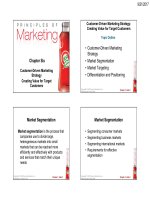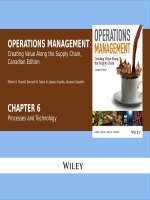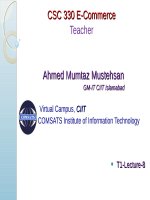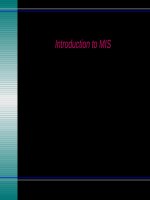Lecture E-Commerce - Chapter 6: Building e-commerce web sites (part I)
Bạn đang xem bản rút gọn của tài liệu. Xem và tải ngay bản đầy đủ của tài liệu tại đây (2.11 MB, 53 trang )
CSC 330 E-Commerce
Teacher
Ahmed Mumtaz Mustehsan
GM-IT CIIT Islamabad
•
•
Virtual Campus, CIIT
COMSATS Institute of Information Technology
•
T1-Lecture-6
Building E-Commerce Web Sites
Chapter-3
Part-I
T1-Lecture-6
For Lecture Material/Slides Thanks to:
Copyright © 2010 Pearson Education, Inc
Objectives
Explain
the process that should be followed in building
an e-commerce Web site.
Describe the major issues surrounding the decision to
outsource site development and/or hosting.
Identify and understand the major considerations
involved in choosing Web server and e-commerce
merchant server software.
Understand the issues involved in choosing the most
appropriate hardware for an e-commerce site.
Identify additional tools that can improve Web site
performance.
T1-Lecture-6
Ahmed Mumtaz Mustehsan
Copyright © 2010 Pearson Education, Inc
1-3
Building an E-commerce Site:
A Systematic Approach
Most important management challenges:
Developing
a clear understanding of business
objectives.
The
objectives are to be explained to the developers
and programmers.
Knowing
how to choose the right technology to
achieve those objectives
T1Lecture6 Ahmed Mumtaz Mustehsan Copyright © 2010 Pearson Education, Inc
1-4
Pieces of the Site-Building Puzzle
Main areas where you will need to make decisions:
Human
resources and organizational capabilities
◦Creating team with skill set needed to build and
manage a successful site
Hardware
Software
Telecommunications
Site
design
T1Lecture6 Ahmed Mumtaz Mustehsan Copyright © 2010 Pearson Education, Inc
1-5
The Systems Development Life Cycle
Methodology for understanding business objectives of
a system and designing an appropriate solution
Five
major steps:
1. Systems analysis/planning
2. Systems design
3. Building the system
4. Testing
5. Implementation
T1Lecture6 Ahmed Mumtaz Mustehsan Copyright © 2010 Pearson Education, Inc
1-6
Web Site Systems Development Life Cycle
T1-Lecture-6
Ahmed Mumtaz Mustehsan
Copyright © 2010 Pearson Education, Inc
1-7
1. System Analysis/Planning
Business objectives:
List of capabilities you want your site to have
System functionalities:
List of information system capabilities needed to
achieve business objectives
Information requirements:
Information elements that system must produce in
order to achieve business objectives
T1Lecture6 Ahmed Mumtaz Mustehsan Copyright © 2010 Pearson Education, Inc
1-8
T1Lecture6 Ahmed Mumtaz Mustehsan Copyright © 2010 Pearson Education, Inc
1-9
2. Systems Design:
Hardware and Software Platforms
System design specification:
Description of main components of a system and their
relationship to one another
Two components of system design:
1.Logical design
Data flow diagrams, processing functions,
databases
1.Physical design
Specifies actual physical, Hardware and software
components, models, etc. needed for the
implementation of Logical design
T1Lecture6 Ahmed Mumtaz Mustehsan Copyright © 2010 Pearson Education, Inc
110
Logical Design for a Simple Web Site
T1Lecture6 Ahmed Mumtaz Mustehsan Copyright © 2010 Pearson Education, Inc
111
Physical Design for a Simple Web Site
T1Lecture6 Ahmed Mumtaz Mustehsan Copyright © 2010 Pearson Education, Inc
112
Build/Host Your Own versus Outsourcing
Outsourcing:
Hiring
site
vendors to provide services involved in building
Build own vs. outsourcing:
Build your own requires team with diverse skill set;
choice of software tools; both risks and possible benefits
Host own vs. outsourcing
Hosting: hosting company responsible for ensuring site
is accessible 24/7, for monthly fee
Co-location:
firm purchases or leases Web server (with
control over its operation), but server is located at
vendor’s facility
T1Lecture6 Ahmed Mumtaz Mustehsan Copyright © 2010 Pearson Education, Inc
113
Choices in Building and Hosting
T1Lecture6 Ahmed Mumtaz Mustehsan Copyright © 2010 Pearson Education, Inc
114
Testing, Implementation, and Maintenance
Testing
Unit testing
unit testing involves testing the site’s program modules
one at a time
System testing
system testing involves testing the site as a whole, in a
way the typical user will use the site.
Acceptance testing
acceptance testing verifies that the business
objectives of the system as originally conceived are in
fact working
T1Lecture6 Ahmed Mumtaz Mustehsan Copyright © 2010 Pearson Education, Inc
115
Testing, Implementation, and Maintenance
Implementation and maintenance:
Maintenance is ongoing process
Maintenance costs: parallel to development costs
Benchmarking
benchmarking a process in which the site is compared
with those of competitors in terms of response speed,
quality of layout and design
T1Lecture6 Ahmed Mumtaz Mustehsan Copyright © 2010 Pearson Education, Inc
116
Factors in Web Site Optimization
T1Lecture6 Ahmed Mumtaz Mustehsan Copyright © 2010 Pearson Education, Inc
117
Web Site Budgets
From $5,000 to millions of dollars/year
Depends on what you can afford
Components of budget:
System maintenance
System development
Content design & development
Hardware
Telecommunications
Software.
T1Lecture6 Ahmed Mumtaz Mustehsan Copyright © 2010 Pearson Education, Inc
118
Simple versus Multi-tiered Web Site
Architecture
System architecture
Arrangement of software, machinery, and tasks in an
information system needed to achieve a specific
functionality.
Single Tier Architecture
it consisted of a server computer running basic Web
server software.
Two-tier
Web server and database server
Multi-tier
Web application servers
Backend, legacy databases
T1Lecture6 Ahmed Mumtaz Mustehsan Copyright © 2010 Pearson Education, Inc
119
Two-Tier E-commerce Architecture
T1Lecture6 Ahmed Mumtaz Mustehsan Copyright © 2010 Pearson Education, Inc
120
Multi-tier E-commerce Architecture
T1Lecture6 Ahmed Mumtaz Mustehsan Copyright © 2010 Pearson Education, Inc
121
Privativate Lines
CSU/DSU ROUTER
Internet
CSU/DSU ROUTER
VPN Concentratror
CSU/DSU ROUTER
VPN Concentratror
CSU/DSU ROUTER
Router
Load balancer
Router
Server
Server
Server Server Server
Server
Server
Server Server
Load balancer
Server
Server
Server
Server
Server
Server
CSU/DSU ROUTER
Load balancer
CSU/DSU ROUTER
Switch
Firewall
Server
Server Server
CSU/DSU ROUTER
Msg Server Farm
Firewall
Firewall
CSU/DSU ROUTER
Load balancer
Firewall
switch
Firewall
Switch
Switch
Switch
Minicomputer
Firewall
Disk array
Server Server
Server Server Server
Server
Server
Server
Server Server Server Server Server Server
Minicomputer
Server
Server Server Server Server
Server Server ServerServer Server Server
Switch
Web Server farm
Minicomputer
Server
Server
Disk array
Server
Switch
Switch
Switch
Switch
Application Server farm
T1Lecture6 Ahmed Mumtaz Mustehsan
Copyright © 2010 Pearson Education, Inc
Minicomputer
Switch
DB SERVER FARM
122
Web Server Software
Apache
Leading Web server software (47% of market)
Works only with UNIX, Linux OSs
Microsoft’s Internet Information Server (IIS)
Second major Web server software (25% of market)
Windows-based
T1Lecture6 Ahmed Mumtaz Mustehsan Copyright © 2010 Pearson Education, Inc
123
Functionalities of Webserver
T1Lecture6 Ahmed Mumtaz Mustehsan Copyright © 2010 Pearson Education, Inc
124
Site Management Tools
Basic tools
Included
Verify
in all Web servers
that links on pages are still valid
Identify
orphan files
Third-party software and services for advanced site
management
Monitor
customer purchases, marketing campaign
effectiveness, etc.
Examples: WebTrends Analytics 9, Google Analytics
/>
T1Lecture6 Ahmed Mumtaz Mustehsan Copyright © 2010 Pearson Education, Inc
125









